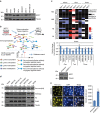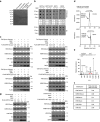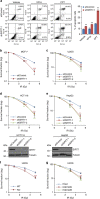SIRT7 is a histone desuccinylase that functionally links to chromatin compaction and genome stability
- PMID: 27436229
- PMCID: PMC4961794
- DOI: 10.1038/ncomms12235
SIRT7 is a histone desuccinylase that functionally links to chromatin compaction and genome stability
Abstract
Although SIRT7 is a member of sirtuin family proteins that are described as NAD(+)-dependent class III histone deacetylases, the intrinsic enzymatic activity of this sirtuin protein remains to be investigated and the cellular function of SIRT7 remains to be explored. Here we report that SIRT7 is an NAD(+)-dependent histone desuccinylase. We show that SIRT7 is recruited to DNA double-strand breaks (DSBs) in a PARP1-dependent manner and catalyses desuccinylation of H3K122 therein, thereby promoting chromatin condensation and DSB repair. We demonstrate that depletion of SIRT7 impairs chromatin compaction during DNA-damage response and sensitizes cells to genotoxic stresses. Our study indicates SIRT7 is a histone desuccinylase, providing a molecular basis for the understanding of epigenetic regulation by this sirtuin protein. Our experiments reveal that SIRT7-catalysed H3K122 desuccinylation is critically implemented in DNA-damage response and cell survival, providing a mechanistic insight into the cellular function of SIRT7.
Figures








References
-
- Nasmyth K. A. The regulation of yeast mating-type chromatin structure by SIR: an action at a distance affecting both transcription and transposition. Cell 30, 567–578 (1982). - PubMed
-
- Frye R. A. Phylogenetic classification of prokaryotic and eukaryotic Sir2-like proteins. Biochem. Biophys. Res. Commun. 273, 793–798 (2000). - PubMed
-
- Blander G. & Guarente L. The Sir2 family of protein deacetylases. Annu. Rev. Biochem. 73, 417–435 (2004). - PubMed
Publication types
MeSH terms
Substances
LinkOut - more resources
Full Text Sources
Other Literature Sources
Molecular Biology Databases
Miscellaneous

